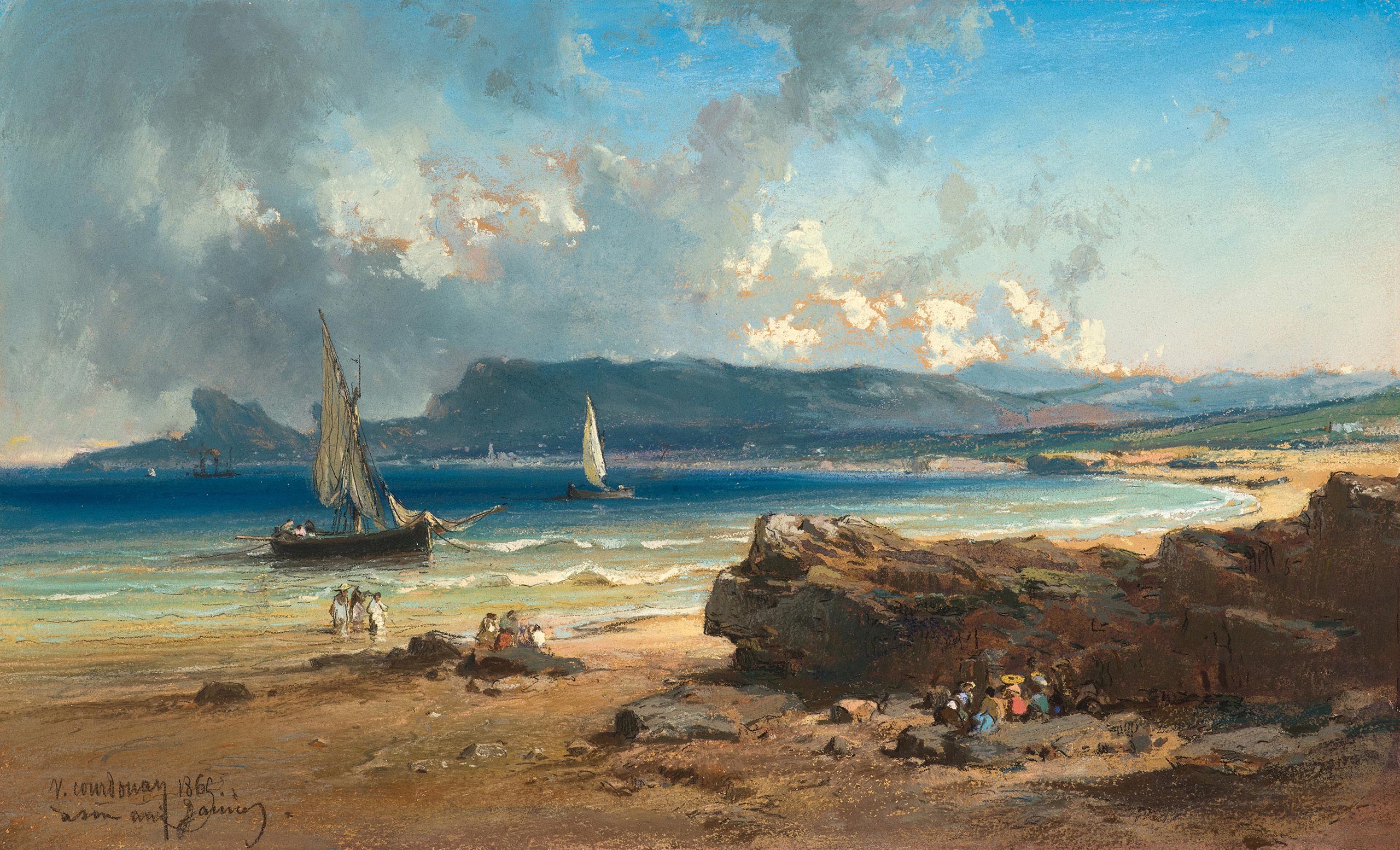
Courdouan
Vincent
Toulon 1810 — 1893
View of the Bay of the
« Bec de l’Aigle », La Ciotat
Pencil, pastel, gouache.
Signed, dated and dedicated V. Courdouan 1865 A son ami Jaincy (?) lower left.
277 x 440 mm (10 15⁄16 x 17 5⁄16 in.)
A pupil of Toulon illustrator and caricaturist Pierre Letuaire, Vincent Courdouan entered the École des Beaux-Arts de la Marine, run by sculptor Félix Brun, before moving to Paris around 1829. There, he studied engraving and entered the studio of a painter also born in Toulon, Jean-Baptiste Paulin Guérin (1783 – 1855), a former pupil of François Gérard and François André Vincent, who not only took him in but also taught him the trade in his Mont-Thabor studio. By the early 1830s, Courdouan was already back in his home town, where he was elected a member of the Académie du Var in 1833 and opened a studio where he taught watercolour and drawing to many of his pupils. Under the reign of Louis-Philippe, Toulon was a port of great importance from which the entire presence of the French fleet in the Mediterranean was organised, including the departure of the Armada for Algiers in 1830 and numerous expeditions, including those of Dumont d’Urville. In this city, Courdouan turned mainly, though not exclusively, to painting seascapes, scenes of combat, fishing, storms and city views.
In 1836, he stayed in Paris, where he made friends with Horace Vernet, Théodore Gudin and Léopold Robert and discovered the forest of Fontainebleau. He travelled to Naples in 1844, Algeria in 1847 and Egypt in 1866. Appointed professor at the Ecole de la Marine in Toulon in 1849, he was awarded the Legion of Honour by Napoleon III in 1852 and became honorary director of the Toulon museum in 1857. He took part in the Paris Salon from 1835 to 1883, where he sent drawings (pencils, pastels) as well as paintings. He also took part in the exhibitions organised by Émile Loubon at the Société des amis des arts de Marseille, as well as those organised by the Société artistique des Bouches du Rhône, in which other Provençal painters such as Ingres, Granet, Delacroix, Decamps, Couture, Courbet, Corot, Rousseau, Troyon, and Diaz took part. Until the early
1840s, Courdouan drew more than he painted, but this trend reversed and he began to produce more canvases, landscapes, particularly seascapes, and Orientalist scenes. His Vallée des Angoisses (1857, Musée de Toulon) bears witness to his innate sense of the spectacular and his still romantic perception of a hostile and savage nature, overwhelming and irrepressible. Similarly, his Vue de la Ponche à Saint-Tropez (Musée d’art de Toulon) shows the small port in the grip of the elements, far from the gentle, luminous images of the southern coast. His vision of Mediterranean nature was inspired by the poetry of his contemporaries and friends, Jean Aicard and Frédéric Mistral. Mistral invited him to join the Félibrige in 1863, an association dedicated to safeguarding and promoting the culture and identity of the Pays de Langue d’Oc.
Courdouan was a tireless and experimental draughtsman. He drew in pencil, for sketches, studies, portraits and scenes of life, as well as in watercolour and gouache. During his trip to Algeria, he produced a large number of views in pencil on bistre paper with strong white highlights. In this very large work, Courdouan, then a very experienced artist, captures with realism and sensitivity the contrasts of light in the bay of Toulon, the charged maritime atmosphere and the vibrations of the air. On the right-hand side, inland, the sky is clear and blue, while floating over the sea, thick clouds gather, their density suggested by the mixture of white, different greys and even ochre tones obtained from the reserve of the paper. The turbulent sea, green, yellow and blue all at once, rolls its bundles of foam towards the beach. The dramatic cut of the rocks in the foreground echoes that of the rock known as the eagle’s beak, which visually closes off the oval formed by the bay, as well as the abrupt shapes of the clouds; the small silhouettes grouping on the beach are highlighted by small patches of colour; all of this helps to include the viewer in the movement of the elements. A large panoramic view painted a few years earlier1 shows the same view of the bay but in a very different atmosphere. Under a clear sky, in the peaceful morning light, the beach appears more serene and less windy, ideal for swimming. The arrangement of the rocks in the foreground has changed slightly. Our drawing is dedicated: Courdouan may have taken this view for a friend who was particularly fond of it.
- Sale, Leclere, Marseille, 21 October 2016, lot 30, oil on wood panel,
signed and dated 1863, 40 x 88 cm.

